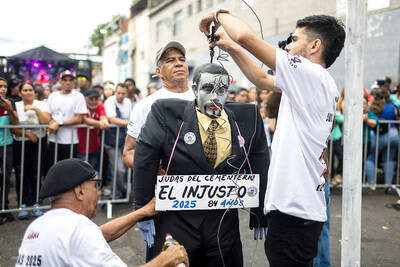Thai troops have pulled back from a hotly disputed border area after an ultimatum from Cambodia, military officials said yesterday, calming fears of armed conflict between the neighbors.
The Cambodian officials said some 80 Thai troops began to withdraw from the area near the ancient Khmer Preah Vihear temple shortly after commanders from both sides held talks during the morning.
It followed an ultimatum from Cambodian Prime Minister Hun Sen, who warned that the soldiers had to pull back by midday or it could become a battle zone.
“They withdrew from the area around 10:20am and went back to their headquarters, which is around 1km away,” Cambodian Brigadier General Yim Pim said.
“There is no more confrontation now. The situation is eased now, but we [are] still on high alert,” he said.
Thai officials at the disputed border refused to confirm whether they had withdrawn.
However, its foreign ministry issued a statement saying Hun Sen’s ultimatum ran “counter to the spirit of neighborliness” and flouted a regional treaty on cooperation.
If Cambodia resorted to force, “Thailand will have to exercise its right of self-defense,” the foreign ministry said, adding it was investigating whether Phnom Penh had violated an international treaty by laying new landmines during the spat.
Speaking at an economic forum in Phnom Penh before the reported withdrawal, Hun Sen maintained his tough rhetoric.
“I have ordered all military commanders to take responsibility for the area. The area is a life and death battle zone,” he said. “Ants can hurt elephants. They [Thais] should not have done this.”
The International Court of Justice ruled back in 1962 that the Preah Vihear Temple belongs to Cambodia, but surrounding land remains in dispute.
Tensions between the neighbors first flared in July after the temple was awarded world heritage status by the UN cultural body UNESCO.
They escalated into a military confrontation, with up to 1,000 Cambodian and Thai troops facing off for six weeks, although both sides in August agreed to reduce troop numbers.
Each country accuses the other of violating its territory.

POLITICAL PRISONERS VS DEPORTEES: Venezuela’s prosecutor’s office slammed the call by El Salvador’s leader, accusing him of crimes against humanity Salvadoran President Nayib Bukele on Sunday proposed carrying out a prisoner swap with Venezuela, suggesting he would exchange Venezuelan deportees from the US his government has kept imprisoned for what he called “political prisoners” in Venezuela. In a post on X, directed at Venezuelan President Nicolas Maduro, Bukele listed off a number of family members of high-level opposition figures in Venezuela, journalists and activists detained during the South American government’s electoral crackdown last year. “The only reason they are imprisoned is for having opposed you and your electoral fraud,” he wrote to Maduro. “However, I want to propose a humanitarian agreement that

ECONOMIC WORRIES: The ruling PAP faces voters amid concerns that the city-state faces the possibility of a recession and job losses amid Washington’s tariffs Singapore yesterday finalized contestants for its general election on Saturday next week, with the ruling People’s Action Party (PAP) fielding 32 new candidates in the biggest refresh of the party that has ruled the city-state since independence in 1965. The move follows a pledge by Singaporean Prime Minister Lawrence Wong (黃循財), who took office last year and assumed the PAP leadership, to “bring in new blood, new ideas and new energy” to steer the country of 6 million people. His latest shake-up beats that of predecessors Lee Hsien Loong (李顯龍) and Goh Chok Tong (吳作棟), who replaced 24 and 11 politicians respectively

Young women standing idly around a park in Tokyo’s west suggest that a giant statue of Godzilla is not the only attraction for a record number of foreign tourists. Their faces lit by the cold glow of their phones, the women lining Okubo Park are evidence that sex tourism has developed as a dark flipside to the bustling Kabukicho nightlife district. Increasing numbers of foreign men are flocking to the area after seeing videos on social media. One of the women said that the area near Kabukicho, where Godzilla rumbles and belches smoke atop a cinema, has become a “real

‘WATER WARFARE’: A Pakistani official called India’s suspension of a 65-year-old treaty on the sharing of waters from the Indus River ‘a cowardly, illegal move’ Pakistan yesterday canceled visas for Indian nationals, closed its airspace for all Indian-owned or operated airlines, and suspended all trade with India, including to and from any third country. The retaliatory measures follow India’s decision to suspend visas for Pakistani nationals in the aftermath of a deadly attack by shooters in Kashmir that killed 26 people, mostly tourists. The rare attack on civilians shocked and outraged India and prompted calls for action against their country’s archenemy, Pakistan. New Delhi did not publicly produce evidence connecting the attack to its neighbor, but said it had “cross-border” links to Pakistan. Pakistan denied any connection to